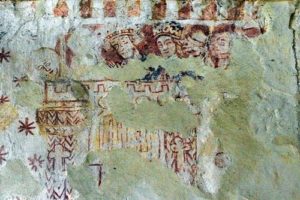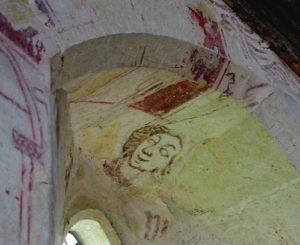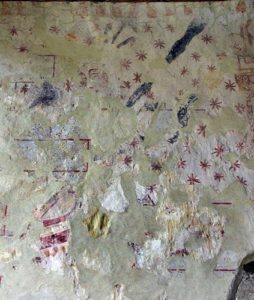St Mary's is a tiny church set back from the road and partially hidden by trees and a wall. It would be easy to miss it as you sped log beaten Cirencester and Fairford. This would be a great shame as it is a lovely little church, a real undiscovered gem.
Originally the village of Amney St MAry would have been around the church. After the Black Death in 1350, the village moved to higher ground about a mile away to the north west, leaving the church isolated. In the 19thC, the parish was amalgamated with Down Ampney and the church fell into disuse and became overgrown by ivy. It was 'rediscovered' in 1913 and the ivy removed. A hundred years later it is still referred to as the 'Ivy Church'. It is one of the few churches to have remained virtually unchanged since Norman times.
It is a simple building. The nave dates from the early 12thC. The chancel was built in the 13thC and the bell cot at the east end of the nave and the south porch were added in the 14thC.
At some time the north door has been blocked but the beautifully carved lintel has a lion (symbol of good) is trampling two serpents (evil) with a winged griffon looking on.
Entry is through the south porch which still has the stone seats used during parish meetings. The original nail studded door is still there, set under a pointed arch.
There is always a sense of excitement the first time we visit a church and open the door. We were not let down. It is a lovely church, untouched by time with a barrel roof with solid beams across with the remains of carved shields along the base. The north wall of the nave is gently collapsing, as is the south wall of the chancel.
At the back of the south wall is a small window carved from single block of stone, which is thought may be Saxon.
Facing the doorway is an ancient tub font with chevron carving around the bowl. A painted corona hangs from the ceiling for candles. Seating is plain wooden benches. The very narrow chancel arch has a low stone screen across the bottom, which is most unusual. near it is the simple wood panelled pulpit.
The chancel is also simply furnished with a choir stall on either side. There is a simple altar rail and a small wood panelled reredos above the high altar. The east window contains 19thC stained glass.
The thing which really catches the attention are the remains of 12-14thC wall paintings. Much of the nave walls are covered with 'stoning' in imitation of blocks of stone. Some have a red 'rose' pattern. Many of the paintings are in poor condition and difficult to decipher, but there are several places where small areas of painting survive in beautiful detail. In a window recess is a super painting of a face.
On the north wall wall is a representation of St Christopher, although you really do need the eye of faith to see this.
On the south wall are a variety of everyday tools including a pair of pincers, a wheel and a horn. There is a man holding a telescope like object to his eye. This apparently, is a singing or whistling arrow which makes a humming noise when swung.
To the left of the south door is a face which is thought to be Christ, leading to the suggestion this is a mural of the Warning to Sabbath Breakers with Christ's wounds bleeding when forbidden tasks are undertaken on the Sabbath Day. To the right of the door are the heads of several people with masonry structures.
This is a very satisfying church, and well worth finding. It is on the A417 between Amney Crucis and Ampney St Peter, nearly opposite the turn to Ampney St Mary. There is a small pull off area on the grass by the road and a tiny sign about the Ivy Church. The church is open every day.










